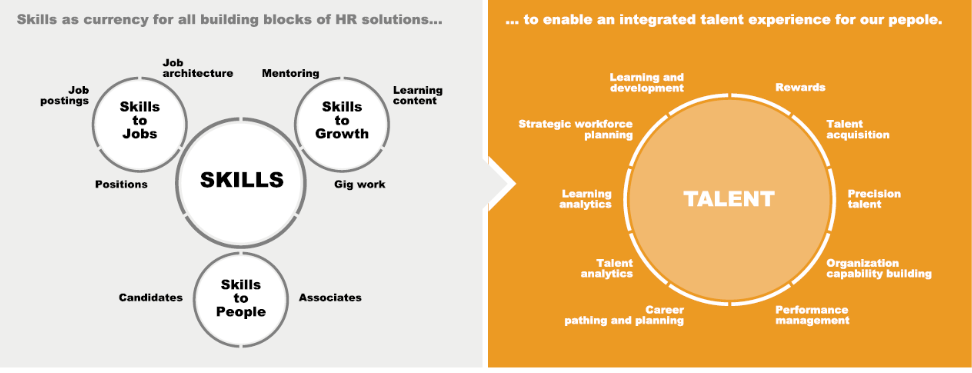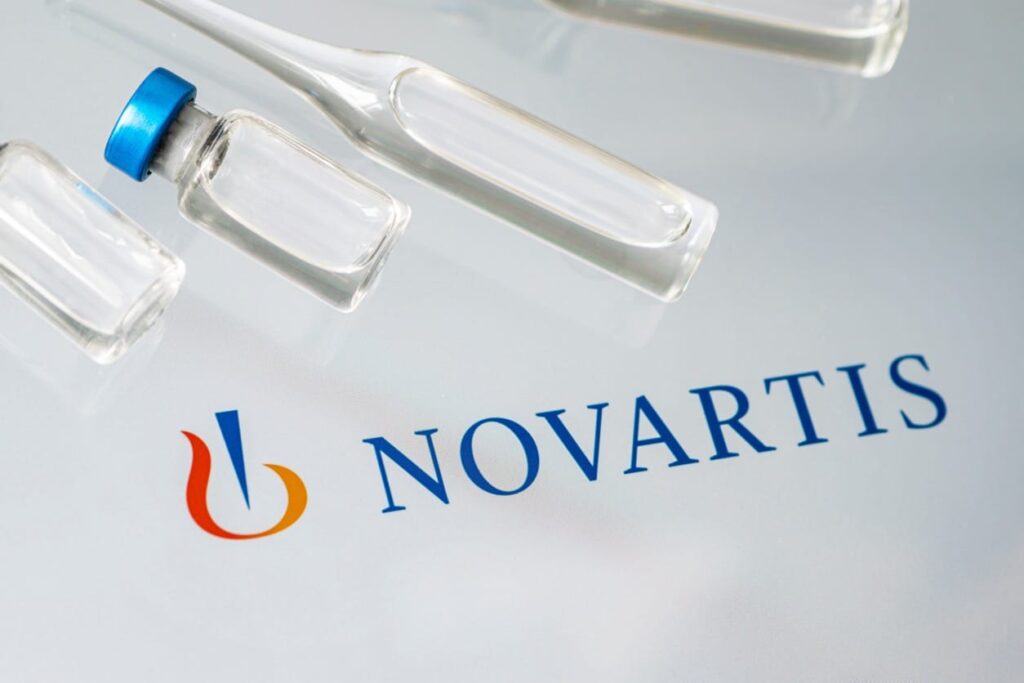
Driven by a purpose to reimagine medicine to improve and extend people’s lives and guided by a vision to become the most valued and trusted pharmaceutical company, Novartis’s life-saving treatments have positively impacted 269 million patients. To equip their workforce with the skills needed to stay at the forefront of the next wave of medical innovations, leaders recognized the need to transition to skills-based models of operating and planning.
Talent marketplace users are
73%
less likely to leave Novartis
Talent marketplace users are
51%
more likely to be promoted
Mapped skills to roles with
33,000
job codes across
105,000
employees
We’re exploring…how we can use skills to gain a deeper understanding of our organization. Instead of functional clusters, there would be workforce and capability clusters, viewing people in terms of the skills they possess. We now have the data and capacity to utilize it in such a manner, and it’s a really powerful approach.
Markus Graf, Vice President, Global Head of Talent at Novartis
Novartis’s purpose is to reimagine medicine to improve and extend people’s lives. They use innovative science and technology to address some of society’s most challenging healthcare issues. Their focus is on discovering and developing breakthrough treatments and finding new ways to deliver them to as many people as possible.

In a world hallmarked by accelerating digital innovation and shifting market demands, leaders at Novartis recognized that they could no longer maintain their traditional siloed talent management approach. Instead, executives sought to embrace skills-based strategies that would enable them to navigate and respond to evolving priorities and emerging challenges.
Since shifting to a project-based work environment would require employees to develop a diverse range of skills, leaders wanted to equip their entire workforce with access to a breadth of learning and development opportunities, including hands-on experiences. Simultaneously, the company sought to reimagine its approach to talent management to focus on a skills-based understanding of work that transcends specific job roles.
Novartis aimed to transform into a more dynamic and skills-based organization for three primary reasons:
1) To stay at the forefront of innovation, executives needed insights into future skill needs and emerging knowledge gaps
2) As the company shifts to project-based work, managers needed to see which specific skills were necessary to perform specific tasks
3) The company needed a more flexible people strategy to swiftly deploy talent to emerging organizational needs
Novartis implemented five “big bets” to optimize its talent strategy to ensure it has the skills and capabilities needed to deliver on business priorities:
These core goals would be supported by four strategic enablers:
In a market that changes as rapidly as the pharmaceutical industry, Novartis needed to understand fast-emerging trends like omnichannel customer engagement and digitization tools. To gain a complete picture of their workforce’s capabilities and the emerging learning and development priorities that would prove most crucial, Novartis harnessed Gloat’s Skills Foundation to harmonize data across disparate systems, in turn enabling the organization to create a unified job architecture.
In describing how Gloat’s Skills Foundation equips leaders with complete visibility into workforce capabilities and skill needs, Rene Gessenich, former Head of Strategic Workforce Planning says, “We can get the top skills against any job in our job architecture and have that updated. Then, we do workforce planning where we go into much more detail and see what the roles are, how they’re changing, and what roles we need.” By taking a skills-based approach to strategic workforce planning, Novartis can ensure its people are building the capabilities needed to adapt to a market that is quickly evolving and leaders can gain in-depth insight into the skills employees possess and how these competencies relate to their colleagues’ expertise.
To develop the next generation of managers and executives, Novartis’s workforce needed complete visibility into internal opportunities that would enable them to hone the capabilities required to lead with confidence. Launching a talent marketplace (which Novartis calls Talent Match) would enable employees to explore and acquire new skills beyond the jobs they were initially hired for. The platform would also expand flexibility, in turn encouraging individuals to grow further within the organization and develop both technical knowledge and soft skills.
Sara Steiner, Global Head of Talent Marketplace, pinpoints the core question that Novartis was looking to answer by launching a talent marketplace: “How do we inspire our associates to look at the different opportunities that exist and how do we make them curious about them in an unbossed and self-empowered environment so they can really take control of their careers?”.
Developing new expertise is a prerequisite for success for any organization, particularly during times of accelerated innovation and rapidly shifting consumer demands. To keep pace with evolving customer expectations and remain at the forefront of medical innovations, employees across Novartis needed access to learning and development opportunities that would enable them to build in-demand expertise and grow their careers.
In describing Novartis’s ongoing commitment to employee development and the role their talent marketplace would play in helping workers expand their careers, Vice President Markus Graf explains, “The talent marketplace is an end-to-end journey and the main focus for us is in the field of employee development. Our journey always starts with the employee.” (The Josh Bersin Company and Gloat Webinar, 2024)
As talent landscapes grow more competitive and global skill gaps continue to widen, leaders at Novartis wanted to gain insight into which skills would become more important in the new world of work. They also wanted to understand what knowledge they would be able to develop and share internally and when it would be in the company’s best interest to acquire new talent with in-demand expertise.

With the help of Gloat’s Skills Foundation, executives would be able to see which capabilities were on the rise and on the decline, as well as pinpointing emerging knowledge shortages within the company. While the shifting talent landscape had previously made creating a unified skills taxonomy challenging, Gloat helped Novartis create a single source of truth by identifying employee skills; suggesting related skills, inferring skills from individuals’ profiles, and subsequently matching individuals with various opportunities such as mentorships and job placements.
Culture and technology reinforce each other. You can’t match talent to opportunities at scale without technology. For us, it was very clear that we wanted to bring this idea of an ‘unbossed’ culture to life and that’s where a talent marketplace really helps.
Markus Graf, Vice President, Global Head of Talent at Novartis
As Graf explains, “Our culture is centered around ‘unbossing,’ including unbossing the traditional understanding of talent management so that we democratize talent with more access to opportunities.” This type of employee-driven career development not only motivates Novartis’s current workforce but also sends a clear signal to prospective employees that the company is committed to their long-term growth and development. (The Josh Bersin Company and Gloat Webinar, 2024)
Rather than letting traditional talent management tactics limit employees’ growth opportunities, the launch of Novartis’s talent marketplace would give their entire workforce full visibility into relevant projects, gigs, and mentorships. This shift would in turn democratize career development and inspire all employees to pursue new learning experiences that would enable them to achieve their full potential.
With their big bets identified, Novartis set out to turn its skills-based transformation vision into a reality. In order to do this, the organization recognized that embracing a holistic, integrated perspective would enable the company to transition from the skills assessment and understanding phase to an operational one.
To address the complexity of its job architecture, Novartis decided to launch an agile workforce operating system, which includes both Skills Foundation and a talent marketplace, to facilitate the matching of skills and talent with open opportunities across the organization. Creating a unified skills framework was a pivotal step for Novartis in its quest to become a more dynamic, skills-based organization. Their agile workforce OS could seamlessly connect the labor market, the external environment, and the relevant skills to create one single source of truth for strategic workforce planning.
Previously, when the company had attempted to create a single taxonomy independently, it faced challenges because skills impact everything in HR in different ways. “It wasn’t easy, given the continuously evolving landscape,” Graf explains. By identifying employee skills, suggesting related skills, inferring skills from individuals’ profiles, and subsequently matching individuals with various opportunities such as learning, projects, mentoring, and gigs, their agile workforce OS played a pivotal role in driving Novartis’s skills-based transformation.
When employees are looking for more personalized exchanges about their career and development goals, they can turn to the talent marketplace within their agile workforce OS to find a mentor who has relevant expertise. Rather than matching people by role or level of seniority, the platform ensures that menteementor pairings are based on skills and ambitions. As a result, associates have the opportunity to build new connections and work closely with team members they may not otherwise have a chance to collaborate with.

Talent marketplace users are
73%
less likely to leave Novartis
Talent marketplace users are
51%
more likely to be promoted
Mapped skills to roles with
job codes across 105,000 employees
When Novartis launched their agile workforce OS, they first rolled it out with a “test and learn” approach to ensure it provided the type of experience users would recommend to others, with the intent to scale. By starting small among units that were eager to test out the new skills-based talent marketplace, Novartis made improvements in the implementation process.
As the company piloted and learned, it scaled further, allowing for rapid adoption and organic growth. To date, more than 30,000 employees have registered to use their agile workforce OS, predominantly through wordof-mouth recommendations rather than a top-down rollout. “There was no big central campaign,” says Graf. “And it worked quite well. It was a good way to roll it out.” (The Josh Bersin Company and Gloat Webinar, 2024)
Overall, Novartis has seen many benefits from the launch of its agile workforce OS—including a 67% increase in cross-functional project assignments. Employees who use their talent marketplace, Talent Match, to participate in projects are also 73% less likely to leave the organization and 51% more likely to get promoted. Additionally, it has enabled the business to save on consultants and contractors by empowering leaders and managers to tap into talent across the company. Reflecting on the profound changes that their platform has already set into motion, Gessenich notes, “When you think about organizational agility or really think about how to find the right kind of skills for a particular task or project, the talent marketplace is at the heart of matching these two pieces at scale.”
With the ups and downs in the work that we do, we need to make sure that you can still find you energy, your purpose, and your focus. And platforms like Gloat and other things that we provide for our employees really help them to build their learning and build their skills.
Vicki Rawlinson, US CHRO
This info will help our workforce agility experts personalize your experience.